Business Law Report: Employee vs. Independent Contractor Analysis
VerifiedAdded on 2020/05/04
|11
|1774
|80
Report
AI Summary
This business law report addresses two key issues. The first part analyzes the legal distinction between an employee and an independent contractor, using the case of Amanda in Monks Pvt. Ltd. to illustrate the application of relevant legal principles. The report examines factors such as control, financial risk, provision of tools, the ability to subcontract, method of payment, tax deductions, uniform requirements, exclusivity of service, and leave entitlements to determine whether Amanda is an employee or an independent contractor. The second part of the report discusses the validity of the "last in, first off" redundancy criterion, using the case of Ken at Ore Ltd. The report considers the application of this criterion, relevant case law, and contractual terms to determine whether Ken can successfully challenge the redundancy policy. The report concludes that Amanda is likely an independent contractor and that Ken's challenge to the redundancy policy will likely be unsuccessful based on the provided information.

Running head: BUSINESS LAW
Business law
Name of the Student
Name of the University
Author Note
Business law
Name of the Student
Name of the University
Author Note
Paraphrase This Document
Need a fresh take? Get an instant paraphrase of this document with our AI Paraphraser
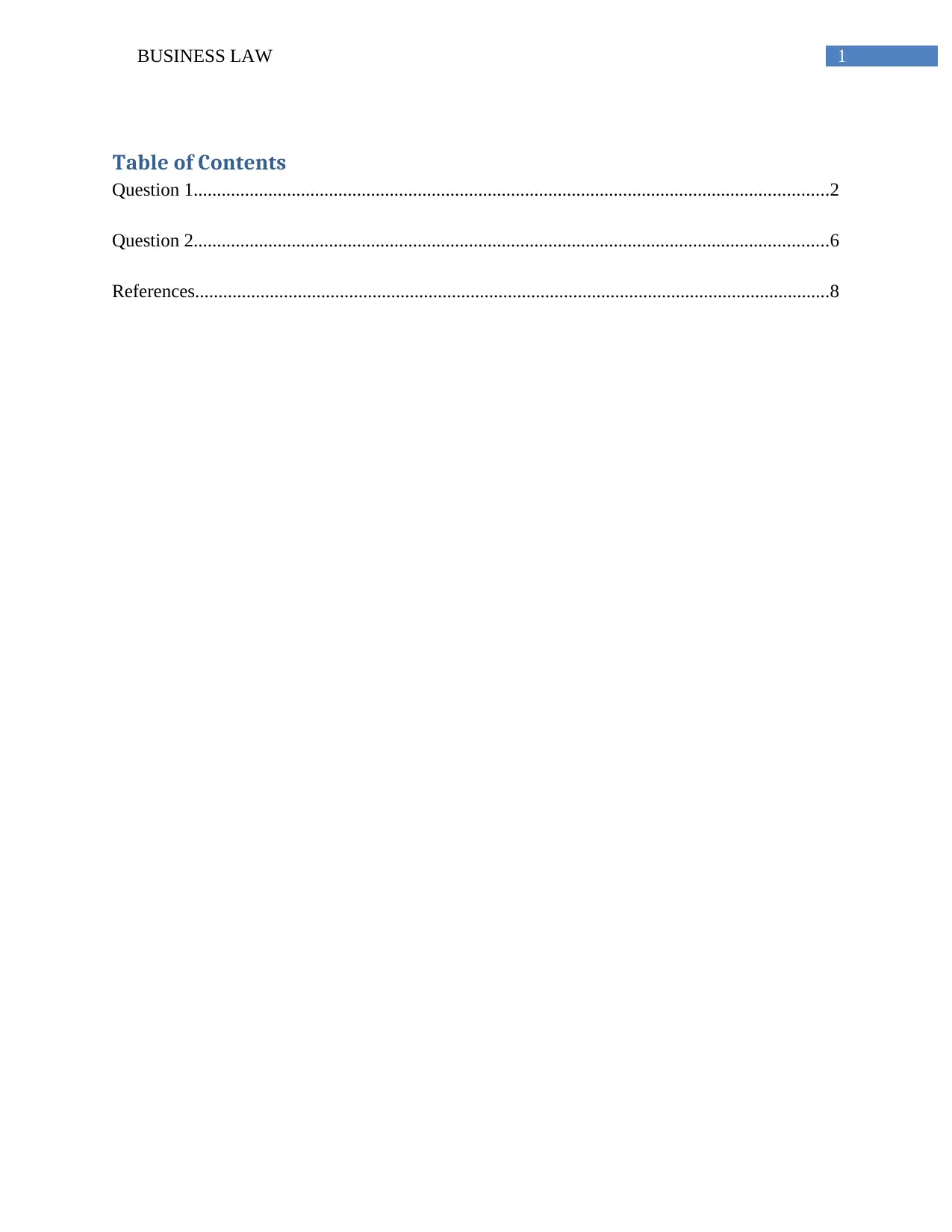
1BUSINESS LAW
Table of Contents
Question 1........................................................................................................................................2
Question 2........................................................................................................................................6
References........................................................................................................................................8
Table of Contents
Question 1........................................................................................................................................2
Question 2........................................................................................................................................6
References........................................................................................................................................8

2BUSINESS LAW
⊘ This is a preview!⊘
Do you want full access?
Subscribe today to unlock all pages.

Trusted by 1+ million students worldwide
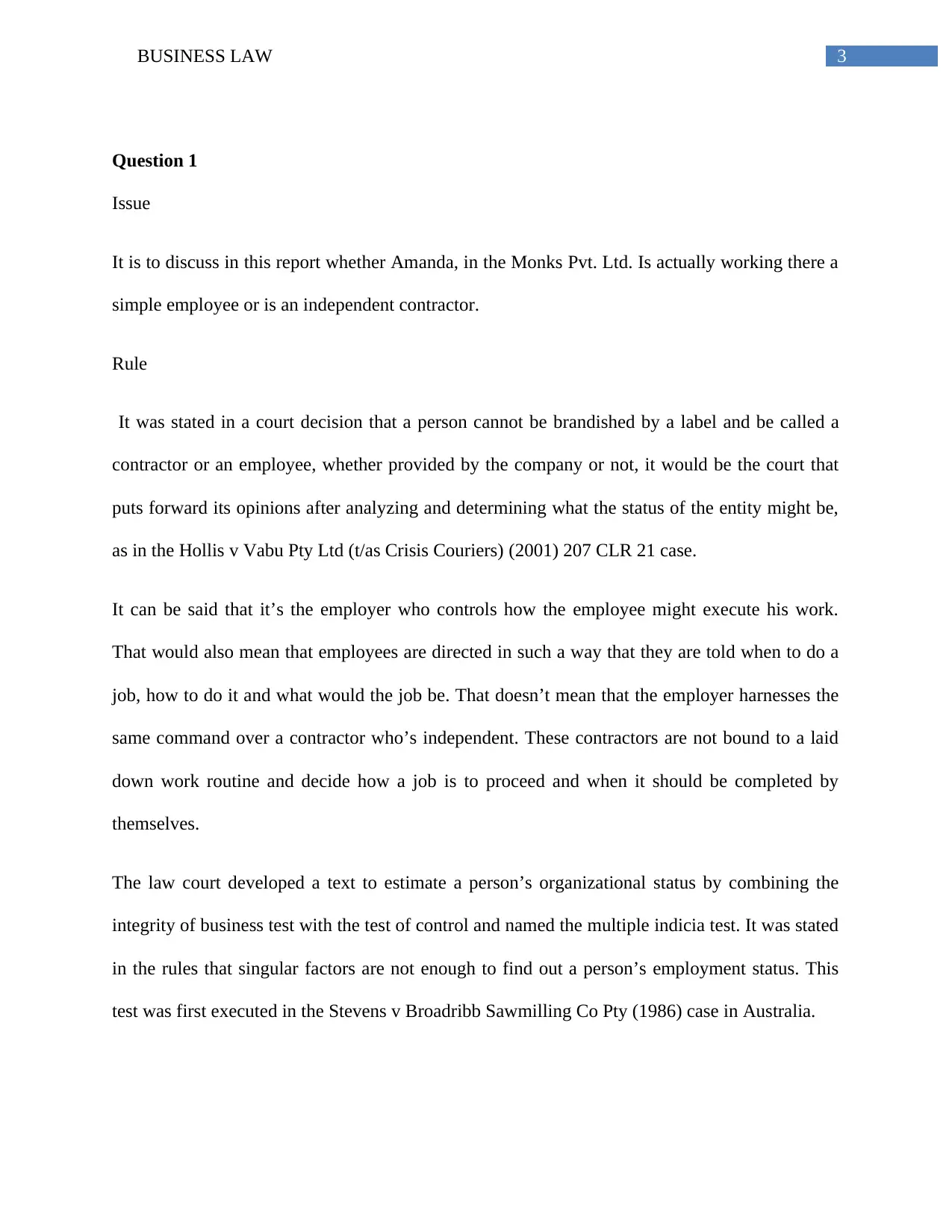
3BUSINESS LAW
Question 1
Issue
It is to discuss in this report whether Amanda, in the Monks Pvt. Ltd. Is actually working there a
simple employee or is an independent contractor.
Rule
It was stated in a court decision that a person cannot be brandished by a label and be called a
contractor or an employee, whether provided by the company or not, it would be the court that
puts forward its opinions after analyzing and determining what the status of the entity might be,
as in the Hollis v Vabu Pty Ltd (t/as Crisis Couriers) (2001) 207 CLR 21 case.
It can be said that it’s the employer who controls how the employee might execute his work.
That would also mean that employees are directed in such a way that they are told when to do a
job, how to do it and what would the job be. That doesn’t mean that the employer harnesses the
same command over a contractor who’s independent. These contractors are not bound to a laid
down work routine and decide how a job is to proceed and when it should be completed by
themselves.
The law court developed a text to estimate a person’s organizational status by combining the
integrity of business test with the test of control and named the multiple indicia test. It was stated
in the rules that singular factors are not enough to find out a person’s employment status. This
test was first executed in the Stevens v Broadribb Sawmilling Co Pty (1986) case in Australia.
Question 1
Issue
It is to discuss in this report whether Amanda, in the Monks Pvt. Ltd. Is actually working there a
simple employee or is an independent contractor.
Rule
It was stated in a court decision that a person cannot be brandished by a label and be called a
contractor or an employee, whether provided by the company or not, it would be the court that
puts forward its opinions after analyzing and determining what the status of the entity might be,
as in the Hollis v Vabu Pty Ltd (t/as Crisis Couriers) (2001) 207 CLR 21 case.
It can be said that it’s the employer who controls how the employee might execute his work.
That would also mean that employees are directed in such a way that they are told when to do a
job, how to do it and what would the job be. That doesn’t mean that the employer harnesses the
same command over a contractor who’s independent. These contractors are not bound to a laid
down work routine and decide how a job is to proceed and when it should be completed by
themselves.
The law court developed a text to estimate a person’s organizational status by combining the
integrity of business test with the test of control and named the multiple indicia test. It was stated
in the rules that singular factors are not enough to find out a person’s employment status. This
test was first executed in the Stevens v Broadribb Sawmilling Co Pty (1986) case in Australia.
Paraphrase This Document
Need a fresh take? Get an instant paraphrase of this document with our AI Paraphraser

4BUSINESS LAW
Such criterions were also used in the Twomey (2012) case to find out the employment status of
an employee and solidify his post as a contractor or a simple employee.
Risks borne by the employees in an organization are very limited or even none. Hence it is seen
that though job is risked when the institution takes a reputational or financial blow, the
employees remain somewhat safe. Whereas, an independent contract will be liable for losses
incurred by an institution since he has his own separate business.
The said employees are sometimes given the tolls required for say a singular purpose of finishing
a job that is given to them. They are also allowed to use separate tools of their own but are
bestowed with allowances in case of such conditions. Whereas, the independent contractor uses
his personal implements and tools in order to complete the job assigned to him.
The duties of an employee cannot be bestowed on someone else by the employee himself, but, a
contractor however, can by all rights hire a subcontractor to execute a job in his stead.
An employee is bound to only receive the salary that is sanctioned to him by the authorities of
the company; the salary can be weekly, hourly or even monthly. The contractor on the other hand
is bound to obtain his payment when and only when the required job is done and the terms and
conditions of payment that were talked about before.
The employer before providing salary to the employee, with the Australian Taxation Office,
deducts any required taxes that are to be excluded as income tax. Whereas, a person ATO
number with the Australian Taxation Office has to be obtained by the independent contractor.
The employee is sometimes bound to be wear a particular uniform provided to them containing a
logo and name of the institute. An Independent Contractor however, doesn’t need a uniform that
Such criterions were also used in the Twomey (2012) case to find out the employment status of
an employee and solidify his post as a contractor or a simple employee.
Risks borne by the employees in an organization are very limited or even none. Hence it is seen
that though job is risked when the institution takes a reputational or financial blow, the
employees remain somewhat safe. Whereas, an independent contract will be liable for losses
incurred by an institution since he has his own separate business.
The said employees are sometimes given the tolls required for say a singular purpose of finishing
a job that is given to them. They are also allowed to use separate tools of their own but are
bestowed with allowances in case of such conditions. Whereas, the independent contractor uses
his personal implements and tools in order to complete the job assigned to him.
The duties of an employee cannot be bestowed on someone else by the employee himself, but, a
contractor however, can by all rights hire a subcontractor to execute a job in his stead.
An employee is bound to only receive the salary that is sanctioned to him by the authorities of
the company; the salary can be weekly, hourly or even monthly. The contractor on the other hand
is bound to obtain his payment when and only when the required job is done and the terms and
conditions of payment that were talked about before.
The employer before providing salary to the employee, with the Australian Taxation Office,
deducts any required taxes that are to be excluded as income tax. Whereas, a person ATO
number with the Australian Taxation Office has to be obtained by the independent contractor.
The employee is sometimes bound to be wear a particular uniform provided to them containing a
logo and name of the institute. An Independent Contractor however, doesn’t need a uniform that
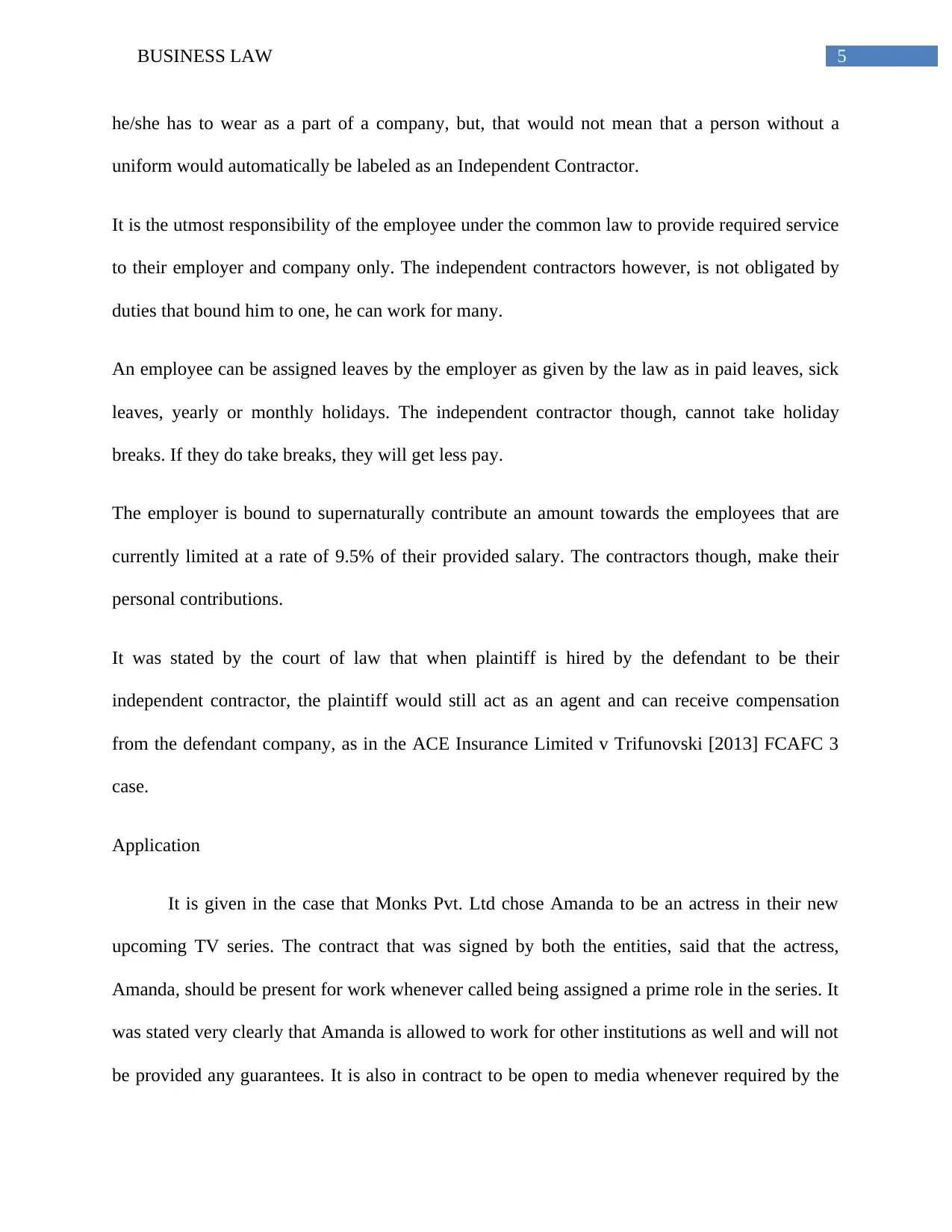
5BUSINESS LAW
he/she has to wear as a part of a company, but, that would not mean that a person without a
uniform would automatically be labeled as an Independent Contractor.
It is the utmost responsibility of the employee under the common law to provide required service
to their employer and company only. The independent contractors however, is not obligated by
duties that bound him to one, he can work for many.
An employee can be assigned leaves by the employer as given by the law as in paid leaves, sick
leaves, yearly or monthly holidays. The independent contractor though, cannot take holiday
breaks. If they do take breaks, they will get less pay.
The employer is bound to supernaturally contribute an amount towards the employees that are
currently limited at a rate of 9.5% of their provided salary. The contractors though, make their
personal contributions.
It was stated by the court of law that when plaintiff is hired by the defendant to be their
independent contractor, the plaintiff would still act as an agent and can receive compensation
from the defendant company, as in the ACE Insurance Limited v Trifunovski [2013] FCAFC 3
case.
Application
It is given in the case that Monks Pvt. Ltd chose Amanda to be an actress in their new
upcoming TV series. The contract that was signed by both the entities, said that the actress,
Amanda, should be present for work whenever called being assigned a prime role in the series. It
was stated very clearly that Amanda is allowed to work for other institutions as well and will not
be provided any guarantees. It is also in contract to be open to media whenever required by the
he/she has to wear as a part of a company, but, that would not mean that a person without a
uniform would automatically be labeled as an Independent Contractor.
It is the utmost responsibility of the employee under the common law to provide required service
to their employer and company only. The independent contractors however, is not obligated by
duties that bound him to one, he can work for many.
An employee can be assigned leaves by the employer as given by the law as in paid leaves, sick
leaves, yearly or monthly holidays. The independent contractor though, cannot take holiday
breaks. If they do take breaks, they will get less pay.
The employer is bound to supernaturally contribute an amount towards the employees that are
currently limited at a rate of 9.5% of their provided salary. The contractors though, make their
personal contributions.
It was stated by the court of law that when plaintiff is hired by the defendant to be their
independent contractor, the plaintiff would still act as an agent and can receive compensation
from the defendant company, as in the ACE Insurance Limited v Trifunovski [2013] FCAFC 3
case.
Application
It is given in the case that Monks Pvt. Ltd chose Amanda to be an actress in their new
upcoming TV series. The contract that was signed by both the entities, said that the actress,
Amanda, should be present for work whenever called being assigned a prime role in the series. It
was stated very clearly that Amanda is allowed to work for other institutions as well and will not
be provided any guarantees. It is also in contract to be open to media whenever required by the
⊘ This is a preview!⊘
Do you want full access?
Subscribe today to unlock all pages.

Trusted by 1+ million students worldwide

6BUSINESS LAW
production house. It is also in her contract that work wages would be given to her monthly but
exclusive of tax deduction.
By what is analyzed and deducted by the set rules in the situation, only one approach can be
made. It was clearly stated in the contractual terms of Amanda that she can freely work for any
other production house, implying to fact that she must be an independent contractor. To that, if
we include another factor of she not actually getting her salary with income taxes deducted from
it that would also indicate her label as a contractor who is independent. On top of all that the
contractual terms mention that her working hours are a minimum of about 50-60 hours weekly
unlike a normal employee’s assigned and designated 48 hours weekly, the discontinuity in her
working routine also point to the fact of her being an independent contractor. He receiving her
salary once in a month may not particularly point to either her being an employee or a contract,
but, by what is seen in her working routine and the term of her being available at any time
demanded or requested solidify her condition as a contractor. But, it is also seen that the
employer had particularly demanded her presence in front of media representatives and reporters
that would mean that they have significant say over her job and have authority over her work.
Even though the employer’s significant hold of power over her, it doesn’t mean that she is
singled out as an employee, as analyzed and discussed in all the above rules. It can clearly be
seen that all her contractual provisions point to the single possibility of her being an independent
contractor and not an employee.
Conclusion
Amanda’s claim to damage is null for she is an independent contractor.
production house. It is also in her contract that work wages would be given to her monthly but
exclusive of tax deduction.
By what is analyzed and deducted by the set rules in the situation, only one approach can be
made. It was clearly stated in the contractual terms of Amanda that she can freely work for any
other production house, implying to fact that she must be an independent contractor. To that, if
we include another factor of she not actually getting her salary with income taxes deducted from
it that would also indicate her label as a contractor who is independent. On top of all that the
contractual terms mention that her working hours are a minimum of about 50-60 hours weekly
unlike a normal employee’s assigned and designated 48 hours weekly, the discontinuity in her
working routine also point to the fact of her being an independent contractor. He receiving her
salary once in a month may not particularly point to either her being an employee or a contract,
but, by what is seen in her working routine and the term of her being available at any time
demanded or requested solidify her condition as a contractor. But, it is also seen that the
employer had particularly demanded her presence in front of media representatives and reporters
that would mean that they have significant say over her job and have authority over her work.
Even though the employer’s significant hold of power over her, it doesn’t mean that she is
singled out as an employee, as analyzed and discussed in all the above rules. It can clearly be
seen that all her contractual provisions point to the single possibility of her being an independent
contractor and not an employee.
Conclusion
Amanda’s claim to damage is null for she is an independent contractor.
Paraphrase This Document
Need a fresh take? Get an instant paraphrase of this document with our AI Paraphraser
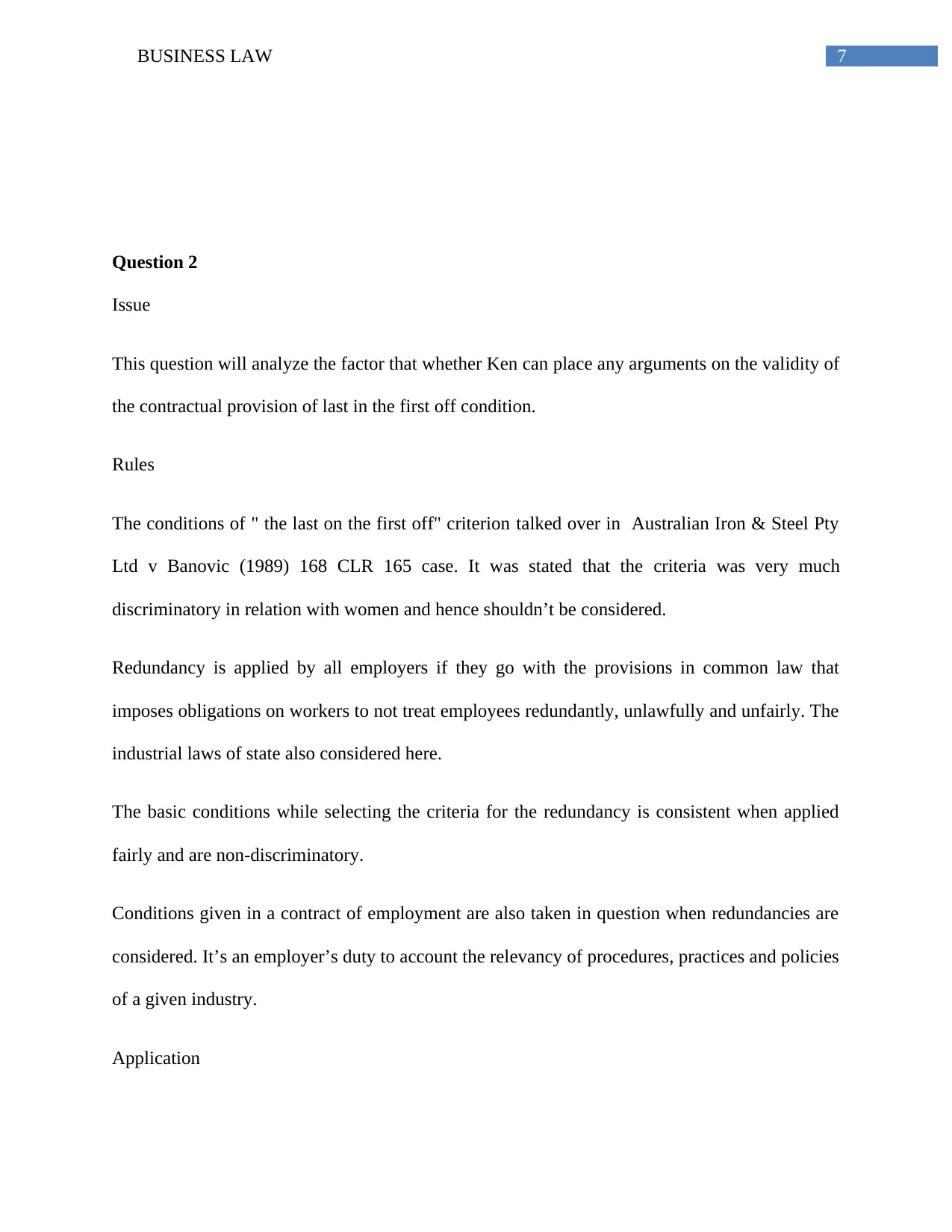
7BUSINESS LAW
Question 2
Issue
This question will analyze the factor that whether Ken can place any arguments on the validity of
the contractual provision of last in the first off condition.
Rules
The conditions of " the last on the first off" criterion talked over in Australian Iron & Steel Pty
Ltd v Banovic (1989) 168 CLR 165 case. It was stated that the criteria was very much
discriminatory in relation with women and hence shouldn’t be considered.
Redundancy is applied by all employers if they go with the provisions in common law that
imposes obligations on workers to not treat employees redundantly, unlawfully and unfairly. The
industrial laws of state also considered here.
The basic conditions while selecting the criteria for the redundancy is consistent when applied
fairly and are non-discriminatory.
Conditions given in a contract of employment are also taken in question when redundancies are
considered. It’s an employer’s duty to account the relevancy of procedures, practices and policies
of a given industry.
Application
Question 2
Issue
This question will analyze the factor that whether Ken can place any arguments on the validity of
the contractual provision of last in the first off condition.
Rules
The conditions of " the last on the first off" criterion talked over in Australian Iron & Steel Pty
Ltd v Banovic (1989) 168 CLR 165 case. It was stated that the criteria was very much
discriminatory in relation with women and hence shouldn’t be considered.
Redundancy is applied by all employers if they go with the provisions in common law that
imposes obligations on workers to not treat employees redundantly, unlawfully and unfairly. The
industrial laws of state also considered here.
The basic conditions while selecting the criteria for the redundancy is consistent when applied
fairly and are non-discriminatory.
Conditions given in a contract of employment are also taken in question when redundancies are
considered. It’s an employer’s duty to account the relevancy of procedures, practices and policies
of a given industry.
Application
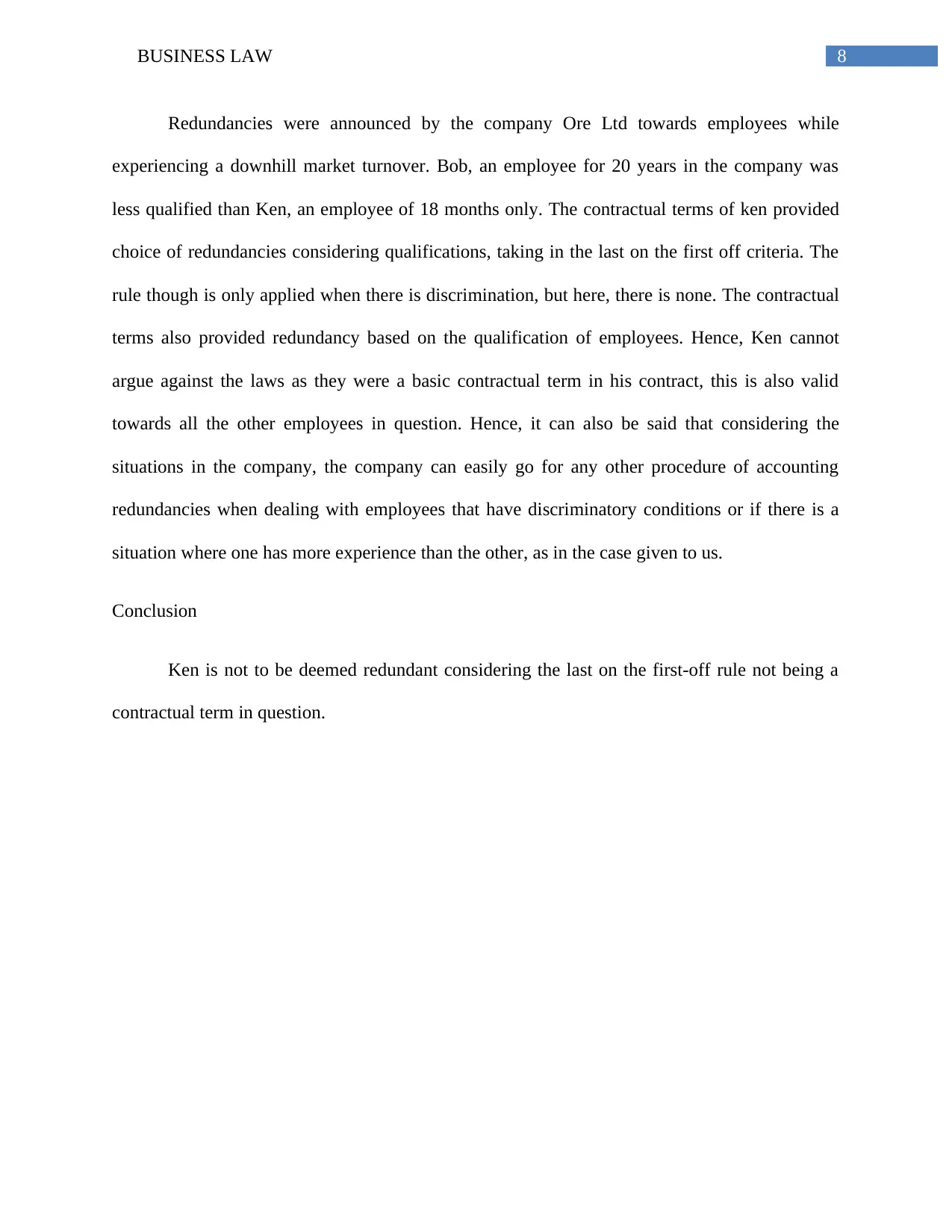
8BUSINESS LAW
Redundancies were announced by the company Ore Ltd towards employees while
experiencing a downhill market turnover. Bob, an employee for 20 years in the company was
less qualified than Ken, an employee of 18 months only. The contractual terms of ken provided
choice of redundancies considering qualifications, taking in the last on the first off criteria. The
rule though is only applied when there is discrimination, but here, there is none. The contractual
terms also provided redundancy based on the qualification of employees. Hence, Ken cannot
argue against the laws as they were a basic contractual term in his contract, this is also valid
towards all the other employees in question. Hence, it can also be said that considering the
situations in the company, the company can easily go for any other procedure of accounting
redundancies when dealing with employees that have discriminatory conditions or if there is a
situation where one has more experience than the other, as in the case given to us.
Conclusion
Ken is not to be deemed redundant considering the last on the first-off rule not being a
contractual term in question.
Redundancies were announced by the company Ore Ltd towards employees while
experiencing a downhill market turnover. Bob, an employee for 20 years in the company was
less qualified than Ken, an employee of 18 months only. The contractual terms of ken provided
choice of redundancies considering qualifications, taking in the last on the first off criteria. The
rule though is only applied when there is discrimination, but here, there is none. The contractual
terms also provided redundancy based on the qualification of employees. Hence, Ken cannot
argue against the laws as they were a basic contractual term in his contract, this is also valid
towards all the other employees in question. Hence, it can also be said that considering the
situations in the company, the company can easily go for any other procedure of accounting
redundancies when dealing with employees that have discriminatory conditions or if there is a
situation where one has more experience than the other, as in the case given to us.
Conclusion
Ken is not to be deemed redundant considering the last on the first-off rule not being a
contractual term in question.
⊘ This is a preview!⊘
Do you want full access?
Subscribe today to unlock all pages.

Trusted by 1+ million students worldwide

9BUSINESS LAW
Paraphrase This Document
Need a fresh take? Get an instant paraphrase of this document with our AI Paraphraser

10BUSINESS LAW
References
ACE Insurance Limited v Trifunovski [2013] FCAFC 3
Australian Iron & Steel Pty Ltd v Banovic (1989) 168 CLR 165
Hollis v Vabu Pty Ltd (t/as Crisis Couriers) (2001) 207 CLR 21
Stevens v Brodribb Sawmilling Co Pty Ltd [1986] HCA 1
Twomey, David. Labor and Employment Law: Text & Cases. Cengage Learning, 2012.
References
ACE Insurance Limited v Trifunovski [2013] FCAFC 3
Australian Iron & Steel Pty Ltd v Banovic (1989) 168 CLR 165
Hollis v Vabu Pty Ltd (t/as Crisis Couriers) (2001) 207 CLR 21
Stevens v Brodribb Sawmilling Co Pty Ltd [1986] HCA 1
Twomey, David. Labor and Employment Law: Text & Cases. Cengage Learning, 2012.
1 out of 11
Related Documents
Your All-in-One AI-Powered Toolkit for Academic Success.
+13062052269
info@desklib.com
Available 24*7 on WhatsApp / Email
![[object Object]](/_next/static/media/star-bottom.7253800d.svg)
Unlock your academic potential
Copyright © 2020–2025 A2Z Services. All Rights Reserved. Developed and managed by ZUCOL.





